 Technology peripherals
Technology peripherals
 AI
AI
 SEEM, a universal segmentation model created by a Chinese team, takes one-time segmentation to a new level
SEEM, a universal segmentation model created by a Chinese team, takes one-time segmentation to a new level
SEEM, a universal segmentation model created by a Chinese team, takes one-time segmentation to a new level
Early this month, Meta released the “Segment Anything” AI model—Segment Anything Model (SAM). SAM is considered a universal basic model for image segmentation. It learns general concepts about objects and can generate masks for any object in any image or video, including objects and image types that have not been encountered during the training process. This "zero-sample migration" capability is amazing, and some even say that the CV field has ushered in a "GPT-3 moment."
Recently, a new paper "Segment Everything Everywhere All at Once" has once again attracted attention. In this paper, several Chinese researchers from the University of Wisconsin-Madison, Microsoft, and Hong Kong University of Science and Technology proposed a new prompt-based interaction model SEEM. SEEM can segment all content in an image or video at once and identify object categories based on various modal inputs given by the user (including text, images, graffiti, etc.). The project has been open sourced and a trial address is provided for everyone to experience.

Paper link: https://arxiv.org/pdf/2304.06718.pdf
Project link: https://github.com/UX-Decoder/Segment-Everything-Everywhere-All-At-Once
Trial address: https://huggingface.co/spaces/xdecoder/SEEM
This study verified the effectiveness of SEEM through comprehensive experiments Effectiveness on various segmentation tasks. Even though SEEM does not have the ability to understand user intentions, it shows strong generalization capabilities because it learns to write different types of prompts in a unified representation space. Furthermore, SEEM can efficiently handle multiple rounds of interactions through a lightweight prompt decoder.
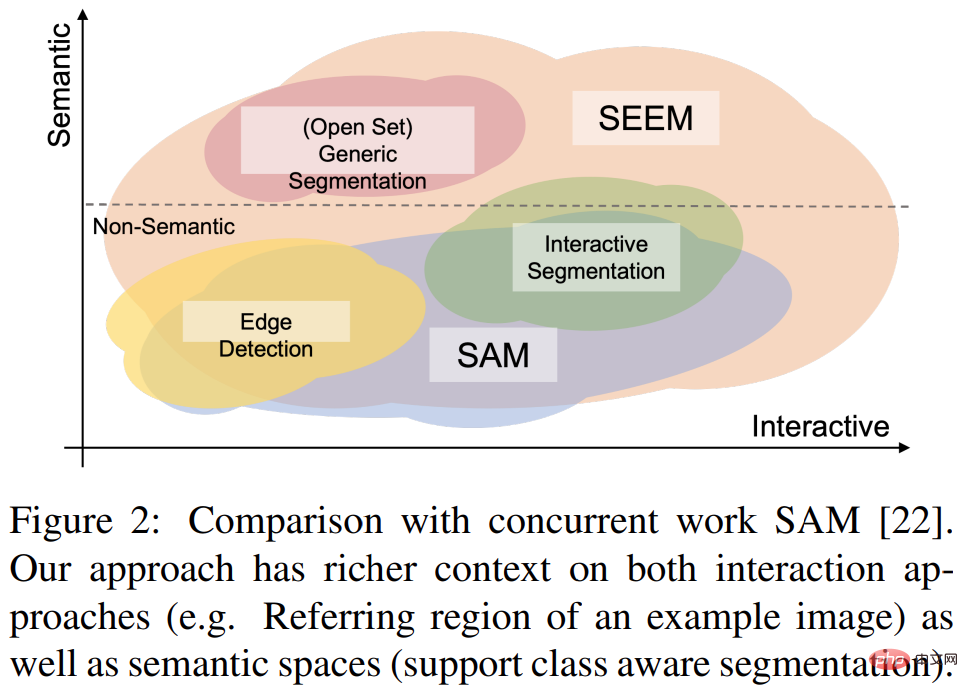
Let’s take a look at the segmentation effect first:
In Transformers Segment "Optimus Prime" in the group photo:

It can also segment a type of object, such as segmenting a landscape picture. All buildings:

SEEM can also easily segment moving objects in the video:

This segmentation effect can be said to be very smooth. Let’s take a look at the approach proposed in this study.
Method Overview
This research aims to propose a general interface for image segmentation with the help of multi-modal prompts. In order to achieve this goal, they proposed a new scheme containing 4 attributes, including versatility, compositionality, interactivity and semantic-awareness, including
1) Versatility This research proposes to combine heterogeneous elements such as points, masks, text, detection boxes (boxes) and even the reference region of another image (referred region) , encoded into prompts in the same joint visual semantic space.
2) Compositionality writes queries on the fly for reasoning by learning a joint visual semantic space of visual and text prompts. SEEM can handle any combination of input prompts.
3) Interactivity: This study introduces the retention of conversation history information by combining learnable memory prompts and cross-attention guided by masks.
4) Semantic awareness: Use a text encoder to encode text queries and mask labels, thus providing open-set semantics for all output segmentation results.
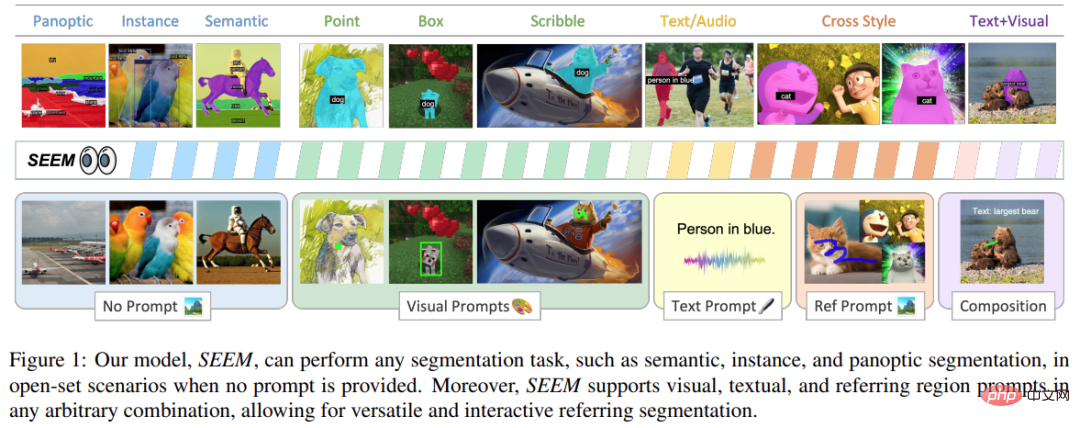
Architecture-wise, SEEM follows a simple Transformer encoder-decoder architecture, and adds an additional text encoding device. In SEEM, the decoding process is similar to generative LLM, but with multimodal inputs and multimodal outputs. All queries are fed back to the decoder as prompts, and image and text encoders are used as prompt encoders to encode all types of queries.
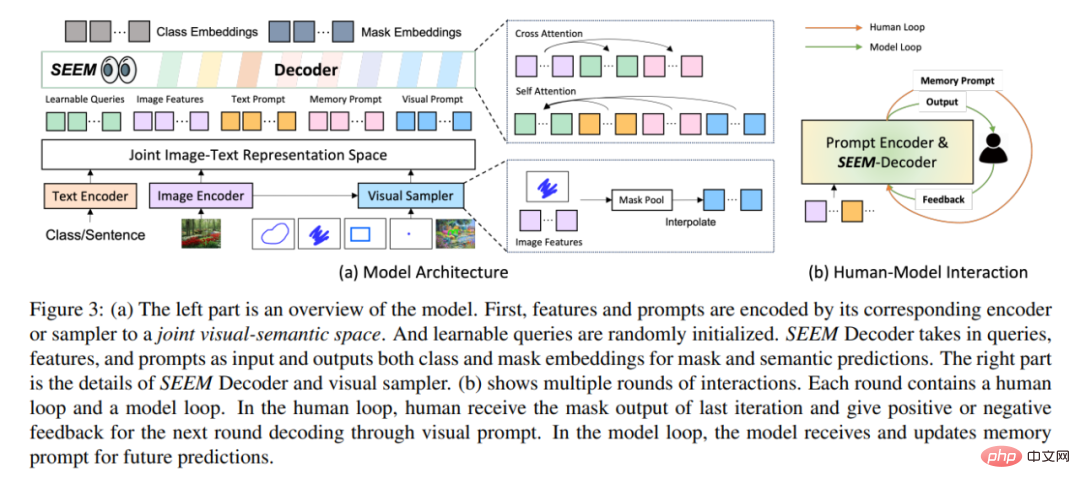
Specifically, this study encodes all queries (such as points, boxes, and masks) into visual prompts, Also use a text encoder to convert text queries into text prompts so that visual and text prompts remain aligned. Five different types of prompts can all be mapped into the joint visual semantic space, and unseen user prompts can be processed through zero-shot adaptation. By training on different segmentation tasks, the model has the ability to handle various prompts. Additionally, different types of prompts can assist each other with cross-attention. Ultimately, SEEM models can use various prompts to achieve superior segmentation results.
In addition to its strong generalization capabilities, SEEM is also very efficient in operation. The researchers used prompts as input to the decoder, so SEEM only had to run the feature extractor once at the beginning over multiple rounds of interaction with humans. On each iteration, just run a lightweight decoder again with a new prompt. Therefore, when deploying the model, the feature extractor with large number of parameters and heavy running burden can be run on the server, while only the relatively lightweight decoder is run on the user's machine to alleviate the network latency problem in multiple remote calls. .
As shown in Figure 3(b) above, in multiple rounds of interaction, each interaction contains a manual loop and a model loop. In the artificial loop, the human receives the mask output of the previous iteration and gives positive or negative feedback for the next round of decoding through visual prompts. During the model loop, the model receives and updates memory prompts for future predictions.
Experimental results
This study experimentally compared the SEEM model with the SOTA interactive segmentation model, and the results are shown in Table 1 below.
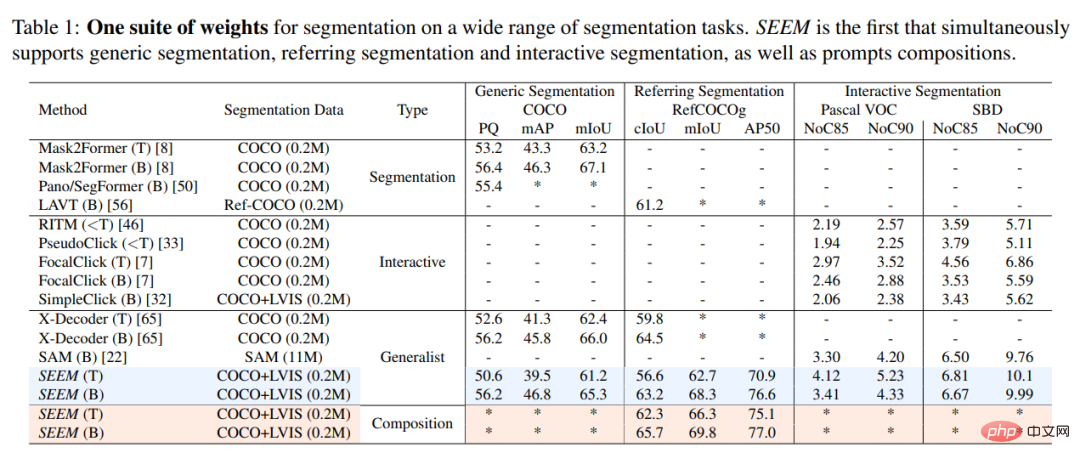
As a general model, SEEM achieves comparable performance to models such as RITM, SimpleClick, and is comparable to the performance of SAM Very close, while SAM uses 50 times more segmented data for training than SEEM.
Unlike existing interactive models, SEEM is the first universal interface that supports not only classic segmentation tasks but also various user input types, including text, points, scribbles, Frames and images, providing powerful combination capabilities. As shown in Table 2 below, by adding combinable prompts, SEEM has significantly improved segmentation performance in cIoU, mIoU and other indicators.
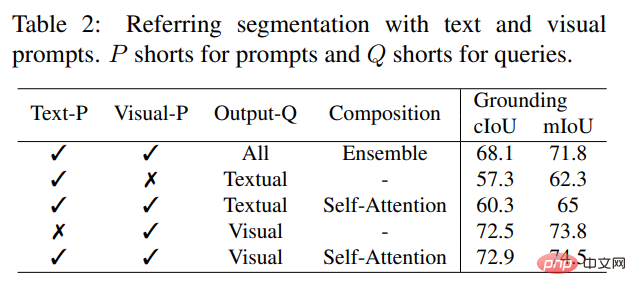
Let’s take a look at the visual results of interactive image segmentation. Users only need to draw a point or simply scribble, and SEEM can provide very good segmentation results
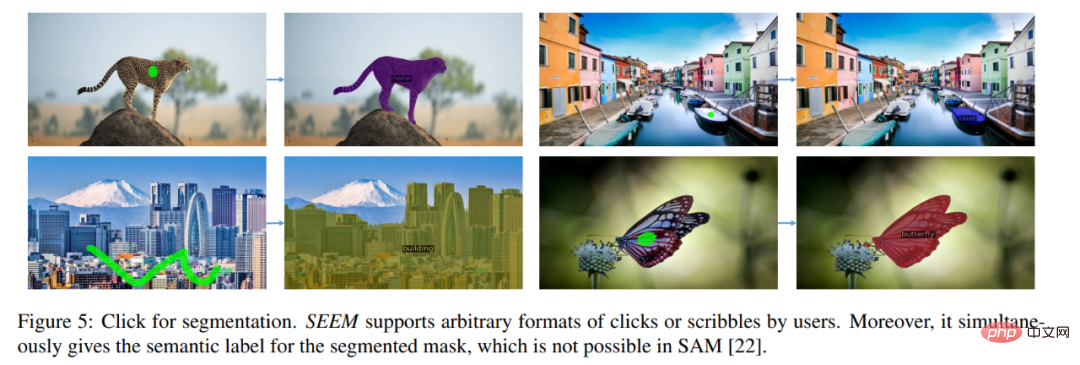
You can also enter Text, let SEEM perform image segmentation

You can also directly input the reference image and point out the reference area, segment other images, and find objects that are consistent with the reference area:
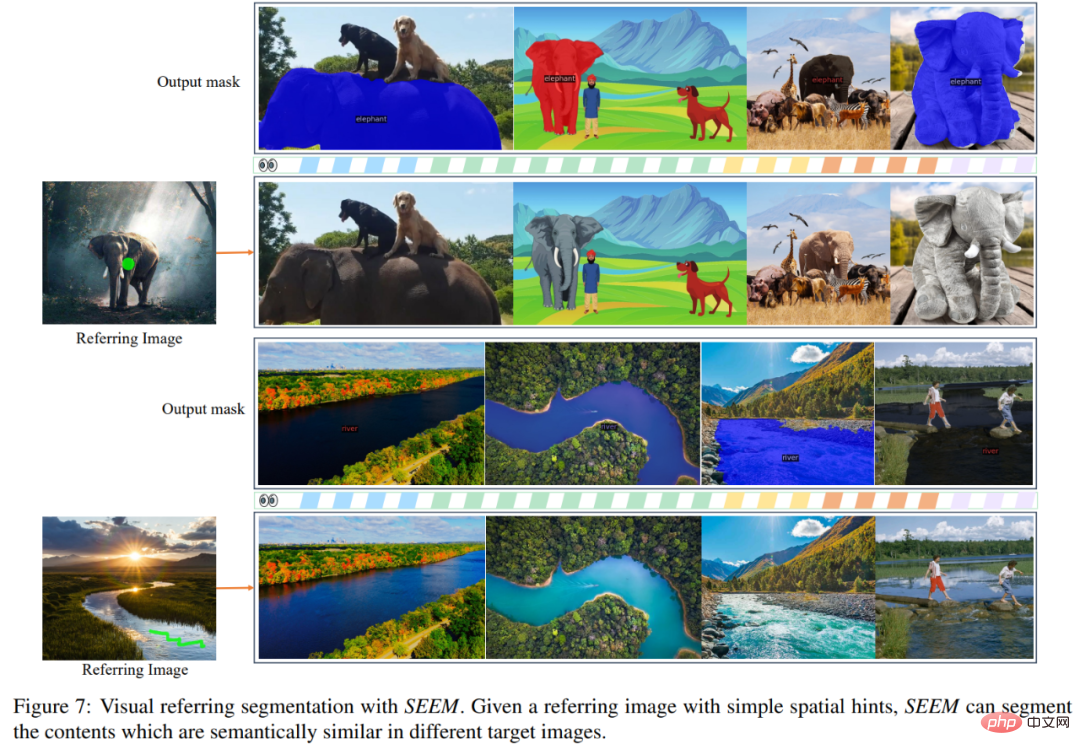
This project is now available for online trial. Interested readers should go and try it.
The above is the detailed content of SEEM, a universal segmentation model created by a Chinese team, takes one-time segmentation to a new level. For more information, please follow other related articles on the PHP Chinese website!

Hot AI Tools

Undresser.AI Undress
AI-powered app for creating realistic nude photos

AI Clothes Remover
Online AI tool for removing clothes from photos.

Undress AI Tool
Undress images for free

Clothoff.io
AI clothes remover

AI Hentai Generator
Generate AI Hentai for free.

Hot Article

Hot Tools

Notepad++7.3.1
Easy-to-use and free code editor

SublimeText3 Chinese version
Chinese version, very easy to use

Zend Studio 13.0.1
Powerful PHP integrated development environment

Dreamweaver CS6
Visual web development tools

SublimeText3 Mac version
God-level code editing software (SublimeText3)

Hot Topics
 1386
1386
 52
52
 The world's most powerful open source MoE model is here, with Chinese capabilities comparable to GPT-4, and the price is only nearly one percent of GPT-4-Turbo
May 07, 2024 pm 04:13 PM
The world's most powerful open source MoE model is here, with Chinese capabilities comparable to GPT-4, and the price is only nearly one percent of GPT-4-Turbo
May 07, 2024 pm 04:13 PM
Imagine an artificial intelligence model that not only has the ability to surpass traditional computing, but also achieves more efficient performance at a lower cost. This is not science fiction, DeepSeek-V2[1], the world’s most powerful open source MoE model is here. DeepSeek-V2 is a powerful mixture of experts (MoE) language model with the characteristics of economical training and efficient inference. It consists of 236B parameters, 21B of which are used to activate each marker. Compared with DeepSeek67B, DeepSeek-V2 has stronger performance, while saving 42.5% of training costs, reducing KV cache by 93.3%, and increasing the maximum generation throughput to 5.76 times. DeepSeek is a company exploring general artificial intelligence
 AI subverts mathematical research! Fields Medal winner and Chinese-American mathematician led 11 top-ranked papers | Liked by Terence Tao
Apr 09, 2024 am 11:52 AM
AI subverts mathematical research! Fields Medal winner and Chinese-American mathematician led 11 top-ranked papers | Liked by Terence Tao
Apr 09, 2024 am 11:52 AM
AI is indeed changing mathematics. Recently, Tao Zhexuan, who has been paying close attention to this issue, forwarded the latest issue of "Bulletin of the American Mathematical Society" (Bulletin of the American Mathematical Society). Focusing on the topic "Will machines change mathematics?", many mathematicians expressed their opinions. The whole process was full of sparks, hardcore and exciting. The author has a strong lineup, including Fields Medal winner Akshay Venkatesh, Chinese mathematician Zheng Lejun, NYU computer scientist Ernest Davis and many other well-known scholars in the industry. The world of AI has changed dramatically. You know, many of these articles were submitted a year ago.
 Google is ecstatic: JAX performance surpasses Pytorch and TensorFlow! It may become the fastest choice for GPU inference training
Apr 01, 2024 pm 07:46 PM
Google is ecstatic: JAX performance surpasses Pytorch and TensorFlow! It may become the fastest choice for GPU inference training
Apr 01, 2024 pm 07:46 PM
The performance of JAX, promoted by Google, has surpassed that of Pytorch and TensorFlow in recent benchmark tests, ranking first in 7 indicators. And the test was not done on the TPU with the best JAX performance. Although among developers, Pytorch is still more popular than Tensorflow. But in the future, perhaps more large models will be trained and run based on the JAX platform. Models Recently, the Keras team benchmarked three backends (TensorFlow, JAX, PyTorch) with the native PyTorch implementation and Keras2 with TensorFlow. First, they select a set of mainstream
 Hello, electric Atlas! Boston Dynamics robot comes back to life, 180-degree weird moves scare Musk
Apr 18, 2024 pm 07:58 PM
Hello, electric Atlas! Boston Dynamics robot comes back to life, 180-degree weird moves scare Musk
Apr 18, 2024 pm 07:58 PM
Boston Dynamics Atlas officially enters the era of electric robots! Yesterday, the hydraulic Atlas just "tearfully" withdrew from the stage of history. Today, Boston Dynamics announced that the electric Atlas is on the job. It seems that in the field of commercial humanoid robots, Boston Dynamics is determined to compete with Tesla. After the new video was released, it had already been viewed by more than one million people in just ten hours. The old people leave and new roles appear. This is a historical necessity. There is no doubt that this year is the explosive year of humanoid robots. Netizens commented: The advancement of robots has made this year's opening ceremony look like a human, and the degree of freedom is far greater than that of humans. But is this really not a horror movie? At the beginning of the video, Atlas is lying calmly on the ground, seemingly on his back. What follows is jaw-dropping
 KAN, which replaces MLP, has been extended to convolution by open source projects
Jun 01, 2024 pm 10:03 PM
KAN, which replaces MLP, has been extended to convolution by open source projects
Jun 01, 2024 pm 10:03 PM
Earlier this month, researchers from MIT and other institutions proposed a very promising alternative to MLP - KAN. KAN outperforms MLP in terms of accuracy and interpretability. And it can outperform MLP running with a larger number of parameters with a very small number of parameters. For example, the authors stated that they used KAN to reproduce DeepMind's results with a smaller network and a higher degree of automation. Specifically, DeepMind's MLP has about 300,000 parameters, while KAN only has about 200 parameters. KAN has a strong mathematical foundation like MLP. MLP is based on the universal approximation theorem, while KAN is based on the Kolmogorov-Arnold representation theorem. As shown in the figure below, KAN has
 Time Series Forecasting NLP Large Model New Work: Automatically Generate Implicit Prompts for Time Series Forecasting
Mar 18, 2024 am 09:20 AM
Time Series Forecasting NLP Large Model New Work: Automatically Generate Implicit Prompts for Time Series Forecasting
Mar 18, 2024 am 09:20 AM
Today I would like to share a recent research work from the University of Connecticut that proposes a method to align time series data with large natural language processing (NLP) models on the latent space to improve the performance of time series forecasting. The key to this method is to use latent spatial hints (prompts) to enhance the accuracy of time series predictions. Paper title: S2IP-LLM: SemanticSpaceInformedPromptLearningwithLLMforTimeSeriesForecasting Download address: https://arxiv.org/pdf/2403.05798v1.pdf 1. Large problem background model
 Tesla robots work in factories, Musk: The degree of freedom of hands will reach 22 this year!
May 06, 2024 pm 04:13 PM
Tesla robots work in factories, Musk: The degree of freedom of hands will reach 22 this year!
May 06, 2024 pm 04:13 PM
The latest video of Tesla's robot Optimus is released, and it can already work in the factory. At normal speed, it sorts batteries (Tesla's 4680 batteries) like this: The official also released what it looks like at 20x speed - on a small "workstation", picking and picking and picking: This time it is released One of the highlights of the video is that Optimus completes this work in the factory, completely autonomously, without human intervention throughout the process. And from the perspective of Optimus, it can also pick up and place the crooked battery, focusing on automatic error correction: Regarding Optimus's hand, NVIDIA scientist Jim Fan gave a high evaluation: Optimus's hand is the world's five-fingered robot. One of the most dexterous. Its hands are not only tactile
 FisheyeDetNet: the first target detection algorithm based on fisheye camera
Apr 26, 2024 am 11:37 AM
FisheyeDetNet: the first target detection algorithm based on fisheye camera
Apr 26, 2024 am 11:37 AM
Target detection is a relatively mature problem in autonomous driving systems, among which pedestrian detection is one of the earliest algorithms to be deployed. Very comprehensive research has been carried out in most papers. However, distance perception using fisheye cameras for surround view is relatively less studied. Due to large radial distortion, standard bounding box representation is difficult to implement in fisheye cameras. To alleviate the above description, we explore extended bounding box, ellipse, and general polygon designs into polar/angular representations and define an instance segmentation mIOU metric to analyze these representations. The proposed model fisheyeDetNet with polygonal shape outperforms other models and simultaneously achieves 49.5% mAP on the Valeo fisheye camera dataset for autonomous driving



